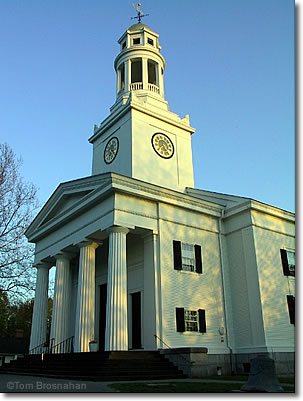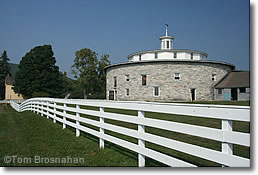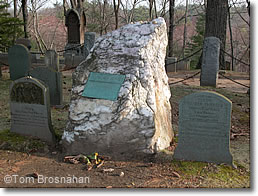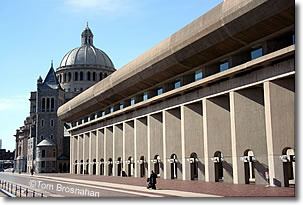New England Religions
New England religion: not just Puritanism. There's lots of religious diversity: Unitarianism, Universalism, Transcendentalism, Shakers, Christian Science and more.

Meetinghouse of First Parish in Concord MA, founded in 1636.
Pilgrims
European immigrants who settled New England in the 1600s were on a quest for religious freedom.
The Pilgrims who debarked from the Mayflower at Plymouth Rock in 1620 left England so they could worship in their own way without difficulty from others.
But New England theologians soon found themselves disagreeing with one another. Except in Roger Williams's Providence, Rhode Island, their belief in freedom of worship extended onty to themselves and their adherents, not to others.
When two New England preachers couldn't agree, one of them (usually the one with fewer followers) left town and established a new congregation with his followers in a new town.
Plentiful land allowed differing religious beliefs to thrive in the same region. This happened when Thomas Hooker of Cambridge MA set off to found Hartford CT, and when Roger Williams founded Providence RI. Williams actually did believe not just in religious freedom but in religious toleration. Soon there was a prosperous synagogue and a tidy Quaker meetinghouse in Newport RI, and more religious diversity to follow.
Puritans
One wag defined a Puritan as someone "who feared that somebody, somewhere, might be having fun."
The strict form of Calvinism called Puritanism sought to "purify" the church of its high-church accretions, and demanded a strict reading of the Bible rather than elaborate interpretations.
Presbyterians wanted a central church governing system, while Congregationalists thought that each congregation could and should be independent of central control.
Though the stern tenets of early American Puritanism suited the colonists harsh life, religion's influence softened as life in the colonies improved.
Puritanism began in the Church of England during the 16th century as a movement to "purify" and simplify the church and bring its practices closer to those described in the Bible.
Adherents believed that the Church of England was too "Catholic," with its rigid hierarchy of bishops and archbishops, its elaborate vestments and rituals and its complicated theology.
The Puritans believed in more simple, "pure" creeds and practices. They held that worship was to follow Biblical rules, and no practice not specifically commended in the Bible should be observed.
Their theology was Calvinist. They believed in predestination (that is, each soul's eternal fate—whether it ends up in heaven or hell—was determined by God at the creation of the world), and no person could change their fate.
It was assumed that those predestined to be "saved" (ie, to go to heaven) would naturally behave in the best possible way, and those predestined to hell would invariably get into mischief.
For church governance, they favored either Presbyterianism (governance by a council of elders), or Congregationalism (democratic governance of each parish by its members).
Unable to reform the Church of England and unwilling to adhere to it, members of a Puritan congregation in Scrooby, near York, emigrated to the Netherlands in 1607, becoming Pilgrims for their faith.
Eventually they came to Plymouth, on Massachusetts Bay, and by 1640 there were 35 Puritan churches in New England.
Mayflower II, a replica of the ship on which 102 Pilgrims sailed for two months to reach Plymouth MA.
Forcefully led by their ministers, the minority of fervent believers became ever stricter and demanding in their religious and social practices, excluding the majority of the population.
By 1692, however, the population of the New England colonies had grown so large, with so many non-religious immigrants, that Puritan influence waned, and what had been founded as a theocratic society based on religious law became a secular polity based on secular law.
The Puritan heritage survives in New England in the number of its independent Congregationalist churches. Their religious beliefs and practices are now mainstream Protestant, but their democratic governance, whereby the congregation chooses the minister and s/he serves at the congregation's pleasure, harks back to the revolutionary ideas of the 16th-century Puritans.
Shakers
Among the most fascinating religions to take shape in New England was the American expression of Shakerism, a Protestant religious sect of the late 18th and 19th centuries noted for quiet, simple living, hard work, mutual support, and quality handicrafts.

Harmonious and efficient Shaker round barn at Hancock Shaker Village near Pittsfield MA.
Shakers believed in a closed community, separate from the world, where men and women lived without mutual physical contact, but worked, prayed and dined in common.
Origins
The United Society of Believers in Christ's Second Appearing or The Millennial Church, more readily known as the Shakers, was a movement begun in 1747 in England as an offshoot of Quakerism.
Ann Lee (1736-1784), a mill worker and cook from Manchester, England, had a vision (about 1770) that she was the manifestation of the Second Coming. Mother Ann, proclaimed that she had received the mother element of the spirit of Jesus Christ.
After being imprisoned for her unorthodox beliefs, Mother Ann and eight followers left England, immigrated to the American colony of New York in 1775 and established a small religious community in Watervliet, New York, near Albany.
Nicknamed Shakers because of the trembling that came upon them during worship from their religious zeal, believed that God has both a male and female nature. The male was embodied in Jesus, the female in Mother Ann.
Though Mother Ann died within a decade in 1784 at age 48, her followers founded other Shaker communities based on the principles of communal possessions, celibacy, pacifism, open confession of sins, and equality of the sexes. Shakerism took hold.
Being a Shaker
In eighteen Shaker communities over 6,000 devotees put their hands to work and their hearts to God. Four of the six surviving Shaker communities are in New England, at Hancock and Harvard, Massachusetts; Sabbathday Lake, Maine; and Canterbury, New Hampshire.
Shakers believed in a closed community, separate from the world, where men and women lived without mutual physical contact, but worked, prayed and dined in common.
Without procreation a sect depends mightily upon proselytization, and the Shakers didn't proselytize much, so the communities had no way to grow except by attracting people to their good example.
The purity and goodness of their lives and their ideals brought adherents in sufficient numbers until the 20th century, when the temptations of modern life led to the slow twilight of the sect.
Visit Shaker Communities
To relive a bit of Shaker history, visit Hancock Shaker Village, in the Berkshire Hills of western Massachusetts; Canterbury Shaker Village near Concord NH; and the Shaker village at Sabbathday Lake ME.
Skaker communities were organized into families of 30 to 90 people. Work was a holy, consecrated act, a belief reflected in the high quality of workmanship and design in Shaker furniture and crafts: In effect, every product was a prayer.
Though converts devoted themselves and all their possessions to the community, they were free to leave at any time.
Celibacy and the onslaught of the 20th century's complex lifestyle put an end to Shakerism after more than two centuries. There are only a handful of the faithful left now, living at the Shaker village at Sabbathday Lake ME.
Shaker designs are still admired and copied, because these good people treated even daily tasks as an art and an offering to the divine.
One cannot help but admire a body of beliefs and a lifestyle based on kindliness, mutual support and hard work.
And yet, as exhibits at Hancock Shaker Village demonstrate, a life of willful denial can lead to privation for some—especially the several children who came to live in Shaker communities with their parents.
A life too simple and basic can be as unfulfilling as a life too rich and elaborate.
Unitarians
"Unitarian" means belief in a single God rather than a "trinitarian" or triune "God in three persons."
What began as doubts about the legitimacy of the 4th-century doctrine of the Trinity progressed during the Enlightenment through the Deism of George Washington and Thomas Jefferson to the liberal theology of Ralph Waldo Emerson and the Transcendentalists.
Three centuries after the life of Jesus, the First Ecumenical Council of Nicaea (325 AD) proclaimed the doctrine of the Trinity, that God was composed of three "persons:" God the Father, God the Son (Jesus Christ) and God the Holy Spirit.
Over the centuries some Christians disputed or renounced this doctrine, arguing that the Bible does not set forth such a position. They argued for what they saw as the original Christian belief based on Judaic monotheism: that there was one God, of whom Jesus was the Son.
During the Reformation in 16th-century Europe, Unitarianism was espoused by several notable theologians, and Unitarian congregations were found (in the minority) in a number of European countries.
In America of the 1700s, Enlightenment belief developed in the direction of Deism, the belief that God was truly understood through the power of Reason and Experience, and best seen in the wonders of Nature. Deism was reportedly the belief of George Washington, Thomas Jefferson and several other prominent American leaders and thinkers.
The early 1800s saw Unitarianism flourish in New England as some Congregational churches affirmed their Unitarian sentiments. At the First Parish in Concord (MA), originally (1636) a Congregationalist-Calvinist congregation, a majority of parishioners held Unitarian beliefs. The Trinitarians in the congregation left the church to build their own Trinitarian Congregational meetinghouse on the opposite side of Concord's Mill Brook.
Ralph Waldo Emerson (1803-1882) graduated from Harvard Divinity School with liberal Christian beliefs, but his thought quickly developed in the direction of Deism, though he defined Deistic beliefs in different terms: God was in each living being, and living beings all together were the totality of God—in Emerson's words, the Oversoul.
Emerson taught that people need not look to religious doctrine or precedent for spiritual guidance, but rather within themselves. The divinity within, revealed through Reason (the great gift of the Creator), would guide them in the right way toward goodness and fulfillment.
Emerson abandoned the pulpit for a life of lecturing and writing, expounding his beliefs in essays and poems. Though a member of First Parish in Concord, he later left the church, discouraged by the "dry, lifeless" preaching of Reverend Barzillai Frost (minister 1837-1857). He renewed his membership in 1865 when Reverend Grindall Reynolds was in the pulpit.
In 1961 the American Unitarian Association joined with the Universalist Church of America to form the Unitarian Universalist Association for administrative purposes.
Today Unitarian Universalism is a covenantal rather than a doctrinal body: instead of affirming that all members share the same beliefs, they covenant (promise together) to support and respect one another in their lives and individual quests for religious fulfillment.
Many Unitarians revere Jesus and his teachings, some consider themselves Christians, but a minority hold to traditional Christian doctrine.
Unitarian Universalists promote peace, tolerance, religious freedom, democracy, assistance to the disadvantaged, and all persons' right to search for religious fulfillment in their own way. Congregations are independent and operate democratically, electing their own officers and appointing their own ministers, who serve at the pleasure of the congregation.
The Unitarian Universalist Association, also democratic, provides organizational guidance and support. Minister-candidates are ordained after examination by other ministers, with confirmation by the Association.
Transcendentalists
Transcendentalists believe that true harmony in life only comes by communing with nature and coming to understand it. This 19th-century philosophical and social movement, although small in scope, had important effects on American thought, literature and religion, especially Unitarianism.
Concord MA was the center of a philosophical and social movement that, although small in scope, had important effects on American thought and literature.
Ralph Waldo Emerson, Henry David Thoreau, Bronson Alcott, and others were all friends living in Concord from about 1836 to 1860. They were aware of the philosophical upheaval going on in Europe at this time, and were encouraged to break away from the Unitarianism that had been their belief.

The grave monument of Ralph Waldo Emerson in Sleepy Hollow Cemetery, Concord MA. A fitting Transcendentalist symbol: a huge uncut quartzite boulder.
Although they never published a manifesto detailing their beliefs, their creed at this time was that each person has a part of God within himself, and by being sensitive to the dictates of that part, can do what is good and right.
Nature had a large share in this belief as well, for the Transcendentalists thought true harmony in life could only be achieved by communing closely with nature and coming to understand it. This, perhaps, was the basis for Thoreau's period of retreat at Walden Pond.
The transcendentalists got together and tried out their beliefs by buying Brook Farm and living with nature there (1841-47).
The Brook Farm experiment, although it failed, has been an example down to our own times. (The farm was in West Roxbury, now a posh suburb of Boston.)
Novelist Nathaniel Hawthorne lived on Brook Farm for a while, and he and his friend Herman Melville were both affected by transcendentalism.
The best way to learn about the transcendentalist movement is to read Emerson's works. If you visit Concord, MA, 15 miles (24 km) west of Boston by road or train, you can tour his house, the Alcotts' Orchard House, The Wayside, where the Alcotts and Hawthorne once lived (at different times), the Old Manse where Nathaniel and Sophia Hawthorne lived soon after their marriage, and also go out to Walden Pond and see the place where Thoreau's famous cabin stood.
You can visit the graves of the most prominent transcendentalists on Authors Ridge in Concord's Sleepy Hollow Cemetery.
Starting from Concord's Monument Square, most of the transcendentalists' homes are east along Lexington Road; Thoreau sites and memorabilia are, appropriately, off by themselves to the southeast.
Christian Science
Perhaps the best-known of New England's religions is Christian Science.
In 1866 a devout New England woman experienced quick recovery from a severe accident, attributing her cure to a glimpse of God's healing power as taught and lived by Jesus.

Christian Science Center, Boston MA.
Thereafter Mary Baker Eddy devoted the remainder of her long life (1821-1910) to better understanding, practicing, and teaching Christian healing, and to founding and promoting the Church of Christ, Scientist.
Today Christian Science, headquartered at the Mother Church in Boston, has branch churches in some 68 countries.
